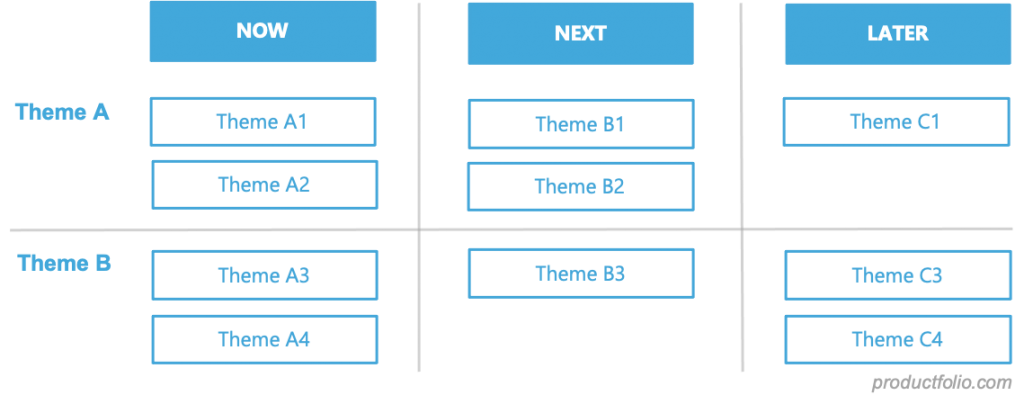What is a Theme-Based Roadmap?
A theme-based roadmap, simply put, is one that is organized into strategic themes. It is similar to an outcome-driven roadmap, except that themes are more descriptive of focus areas than outcomes per se. There is a high degree of similarity though, between theme-based and outcome-based roadmaps. The product team sorts plans and goals into high-level, strategic roadmap categories with this technique.
Theme-based roadmaps are increasingly being advocated for as a better alternative to feature-based roadmaps. Some even describe them as the best. However, you can still get it all wrong with this style of roadmapping, so you need to know the right things to do.

What Are the Benefits of a Theme-Based Roadmap?
It enhances effective discussions among team members
Theme-based roadmaps are visual and clear, possessing all the right qualities you need in this sort of document. This enables teams to have productive debates, with the roadmap providing clear reference points.
Team members can easily use the document to justify or dispute certain plans or decisions. The goals are visually and clearly displayed for all tasks and plans to be linked to them and Objectives and Key Results (OKRs).
It promotes better decisions
A theme-based roadmap can help your team to make improved decisions, both strategically and tactically. Roadmaps, generally, are meant to be strategic documents, but this type may even be more so.
Ideally, you start putting together a theme-based roadmap by trying to find answers to certain strategic questions. For example, “What problems are you looking to solve?” or “What gap in the market do you want to fill?” Your answers will guide what themes to choose to guide your work.
The use of themes also makes it easier for everyone to understand all product decisions.
It reduces explanations
You can reduce the amount of time you spend explaining your roadmap over and again. Theme-based roadmaps offer the benefit of making the reasoning behind your actions a lot more obvious. They clearly show your priorities and why you have settled for them. Everyone can more readily understand what you’re doing or plan to do.
Where Do You Get Your Themes From?
Your customers or target users are a good source of themes for your roadmaps. A theme could come from “a high-level customer need,” according to Product Culture’s Bruce McCarthy. Use research techniques to learn more about customers’ pain points to come up with themes.
The product backlog also provides a good starting point for creating your themes. This is where you usually keep all ideas or tasks that you are considering working on. It offers you something to study for patterns that could inform your strategic initiatives.
The themes you come up with would then be broken down into actionable work. They will have one or more epics under them, with each epic having related features and stories below it.
Theme-based Roadmaps Can Also Disappoint
While supporters are calling for greater adoption, theme-based roadmaps are not failure-proof. There are cases where they fall short in achieving the targeted goals of a business. This is often a result of poor goal-setting or poor execution.
The failure of this roadmapping technique can be brought about by the following, among others:
- Inadequate data to drive plans
- Working with assumptions that are not validated
- Too much influence by the executive or management team on what gets done
- Focusing on what you can do at the expense of what is needed
- Not allowing adequate time to properly consider decisions
The foregoing can result in poor goals. And when you don’t have the right target, you’re less likely to have the right result.
How to Build Effective Theme-Based Roadmaps
What do you do to ensure your theme-based roadmap promotes the desired outcomes and goals? Here are some key steps to follow:
- Define outcomes – You should start by identifying the outcomes that work for both your customers and company. Figure out why they are essential and what makes them worthwhile for both parties.
- Identify initiatives – Come up with initiatives or themes that tackle a problem sufficiently well. Define your priorities with respect to problem areas so that you can incorporate new feedback easily instead of tackling feature requests individually. Show why you are working on these initiatives, including how they support your goals and OKRs. These initiatives form the basis of your product strategy.
- Have the right picture of success – How will you know that you succeeded? This is more about how well you achieve a vital outcome than your ability to deliver a feature. Make sure that your goals are measurable so you can tell if you excelled or fell short.
- Make it collaborative – Your roadmap should come from a group effort. This ensures that every angle is well-covered and that you are not working with wrong assumptions. Involve different stakeholders, including customers, developers, designers, testers, and the marketing team.
- Update often – As with any good roadmap, especially in Agile, your theme-based document is never “finished.” Endeavor to update it as needed to reflect new changes, learnings, and changing priorities.


